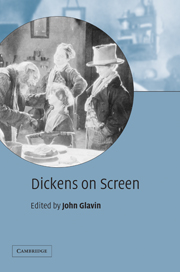Book contents
- Frontmatter
- Contents
- List of illustrations
- Notes on the contributors
- Acknowledgments
- Introduction
- Part I
- Part II
- Part III
- Part IV
- 11 Cinematic Dickens and uncinematic words
- 12 Dickens, Eisenstein, film
- 13 Orson Welles and Charles Dickens 1938–1941
- 14 David Copperfield (1935) and the US curriculum
- 15 Dickens, Selznick, and Southpark
- 16 Tiny Tim on screen: a disability studies perspective
- Part V
- Index
- References
15 - Dickens, Selznick, and Southpark
Published online by Cambridge University Press: 22 September 2009
- Frontmatter
- Contents
- List of illustrations
- Notes on the contributors
- Acknowledgments
- Introduction
- Part I
- Part II
- Part III
- Part IV
- 11 Cinematic Dickens and uncinematic words
- 12 Dickens, Eisenstein, film
- 13 Orson Welles and Charles Dickens 1938–1941
- 14 David Copperfield (1935) and the US curriculum
- 15 Dickens, Selznick, and Southpark
- 16 Tiny Tim on screen: a disability studies perspective
- Part V
- Index
- References
Summary
“Oh my God, they've killed Dickens … you bastards!”
Hollywood has long been the premier battlefield in mass culture's ongoing war between art and commerce. Diplomats from both sides of this campaign worked out a temporary truce, of sorts, during a meeting at London's Savoy Hotel on 16 May 1934. In a heavily publicized conference sponsored by the News Chronicle, Hollywood emissaries David O. Selznick and George Cukor (along with representatives of the British film industry) met with the distinguished board of the Dickens Fellowship, a group of writers and intellectuals serving as the cultural custodians of England's most celebrated nineteenth-century novelist. Their common goal that day was to select the ideal cast for the upcoming MGM production of Dickens's David Copperfield. As the sponsor of the event, the News Chronicle reported that “the Dickensians, headed by their President, Mr. Alfred Noyes, will analyze the main characteristics of the characters in David Copperfield. And the film experts will name the actors they consider could best represent those characters” (14 May 1934). A photo of the event shows Selznick and Cukor squaring off with Noyes and J. B. Priestley, debating the “authentic” essence of Copperfield, Micawber, Uriah Heep, and the other most remembered characters from the novel. Sponsored by the Chronicle as a contest for its readers, the entries that most closely matched those of the expert panel vied for a prize of £500.
- Type
- Chapter
- Information
- Dickens on Screen , pp. 171 - 187Publisher: Cambridge University PressPrint publication year: 2003
References
- 3
- Cited by

